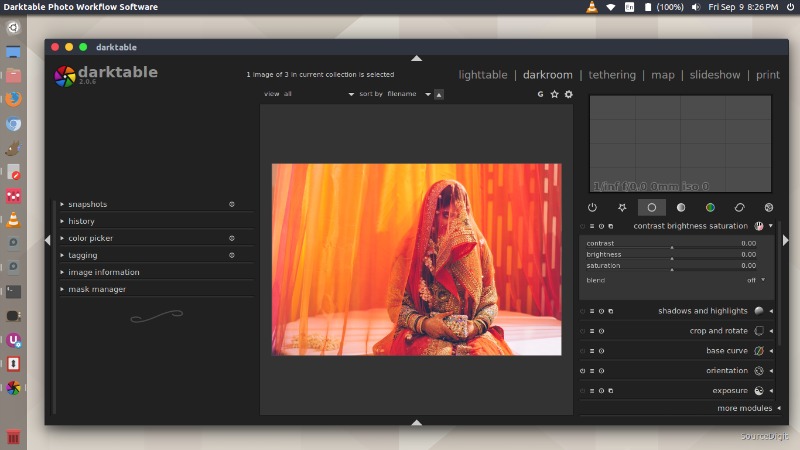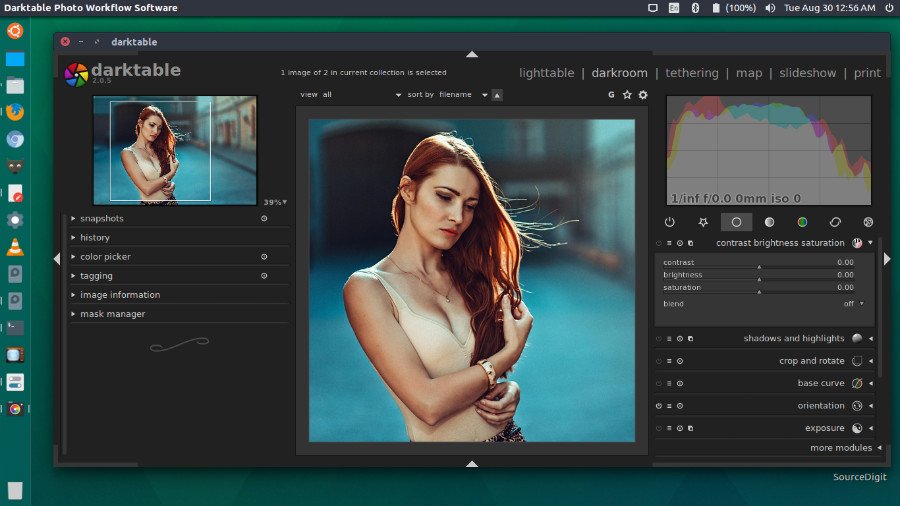Install Darkatable on Linux Ubuntu. Darktable is the best Photoshop alternative for Ubuntu Linux Systems Photoshop.
Darktable is an open source photography workflow application and raw developer . A virtual lighttable and darkroom for photographers. It manages your digital negatives in a database, lets you view them through a zoomable lighttable and enables you to develop raw images and enhance them.

Darktable 3 – New Features And Changes
- A new module for handling 3D RGB Lut transformations (PNG Hald-CLUT and Cube files are supported).
- Many improvements to the ‘denoise (profiled)’ module. The degree of shadow denoising can be controlled, including the correction of color casts (mainly improves high-ISO images). “Auto” modes which infer some parameters from the profile are available, allowing users to create presets which are adaptive to various ISO values. The default values of the sliders are also adapted dynamically on module activation, giving a good trade-off between noise smoothing and detail preservation. The non-local means mode has 2 new options: one to coarse-grain denoising, and one to control the amount of fine detail to preserve. The controls now have soft boundaries, which means that users can use the keyboard to enter values outside the range of the sliders if they need to.
- Along with selecting the ‘soft proof’ color profile, users can now select an additional profile for the color space of the histogram, color picker and overexposed checker. When gamut or softproof checks are active the histogram and color picker use the softproof profile, otherwise they use the new histogram profile (which is always used for overexposure checking).
- A new setting for ‘working profile’ has been added to the input color profile module. This color space will be used by RGB modules between the input and output color profile modules.
- A new color picker has been added to the parametric masking controls which adjusts the range sliders based on the selected area from the image. Click the picker button to adjust the input image slider, Ctrl+click the button to adjust the output image slider.
- The ‘picasa’ target storage in the export module has been completely rewritten to support the new Google Photo API, and renamed ‘google photos’. It is again possible to create albums directly from the export module.
- A new single-line image information display can be positioned at the top (left, right, or center) or bottom (center) of the darkroom view to replace the information previously overlaid on the histogram. The specific information shown can be configured in preferences.
- The ‘tagging’ module is faster, and can now display hierarchical tags in a tree view. Tags can now be designated as ‘private’ (not exported by default), ‘synonym’ (to help search engines), and ‘category’ (not exported, for organizing the tag library). The metadata exported with images can now be configured in the ‘export selected’ module, allowing you to choose which main types are exported, as well as define values for specific tags based on formulas.
- Many code optimizations for CPU and SSE paths. The tone equalizer module introduces a new optimization paradigm (GCC target clones), aimed toward users
- of pre-built Linux packages. The image-processing code will be cloned for several CPU generations (SSE2, SSE3, SSE4, AVX, AVX2) at compilation time, and the best-suited version of the code will be chosen by the system at run time. This experiment is to be generalized to other modules if proven successful, and will allow users of pre-built packages to get the same performance as if the program was specifically compiled for their computer. It needs GCC 9 compiler and does not yet work on Windows due to the lack of support of target clones on the OS side.
- A new preference to expand/collapse a darkroom module when it is activated/deactivated.
- The ‘collect images’ module has a new single-click option featuring range selection for date-time and numeric values.
- The orientation of drawn masks using the ‘gradient’ shape is now clearly displayed with an arrow.
- The ‘graduated density’ module has better accuracy when computing the rotation to avoid sporadic flipping of the gradient.
- Make sure the OpenCL kernel code is recompiled when the driver version is updated.
- Add color pickers for ‘split toning’, ‘graduated density’ and ‘watermark’ modules.
- The color picker positions are kept during editing within a module.
- The map view can zoom on the images of the selected collection.
- The slideshow will now start at the selected images if any, and supports changing the delay between images. It will also now be more responsive when manually moving backward and forward through the images.
- A new ‘basic adjustments’ module has been added. It allows to adjust the black level, exposure, highlight compression, contrast, middle grey, brightness and saturation. It also has an auto feature based on Rawtherapee’s auto levels that can work on the entire image or a user selected area.
- A new ‘rgb curve’ module has been added. It has modes for linked and independent RGB channels. The curves and histogram can be displayed using
- the working profile or can be scaled to be 50% grey. A secondary color picker will add 4 nodes to the curve based on the area selected in the image: min, average, middle, and max.
- A new ‘rgb levels’ module has been added. It has linked and independent channels, preserve colors option and is native RGB.
- A new search box has been added to the module groups in the darkroom view, with configuration options to show only the module groups, only the search box, or both. Modules are searched for by (localized) name, and when displaying only the search box, the active modules are shown when the box is empty. A shortcut can be set for focusing the box.
- A preview window has been added to the darkroom that displays the edited image on a separate window.
- A new option ‘skip’ is added to the ‘on conflict’ setting on the export module which skips the exporting to existing destination files.
- Allow to switch between clone/heal and blur/color modes in ‘retouch’ module after creating a shape using Ctrl+click on corresponding mode icon.
- An accels window (H) has been added to summarize all available shortcuts and mouse actions available in the current context.
- A zoom & pan feature has been added to lighttable full preview.
- The base-curve module is now using luminance color preservation by default. This can give slightly less saturated pictures compared to the previous version where no color preservation was made. But it will generally avoid color shift.

Install Darktable On Ubuntu Linux
Run the following commands in terminal to install Darktable on Ubuntu Linux Systems:
sudo add-apt-repository ppa:ubuntuhandbook1/darktable
sudo apt-get update
sudo apt-get install darktable
Unistall Darktable
Run the following commands to uninstall and remove Darktable:
sudo apt remove darktablesudo add-apt-repository -r ppa:ubuntuhandbook1/darktable
